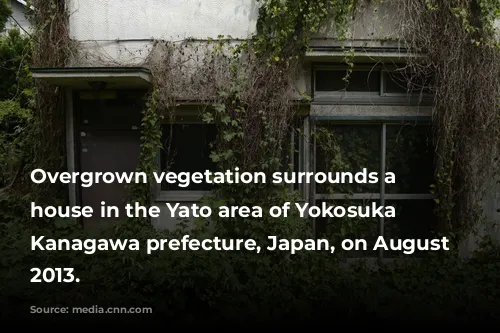Japan is facing a unique problem: a surplus of homes and a shrinking population. The country currently has a staggering nine million vacant houses – enough to house everyone in New York City! This alarming statistic is a direct consequence of Japan’s declining birth rate and aging population.
These abandoned homes, known as “akiya,” are scattered throughout the country, even in major cities like Tokyo and Kyoto. This situation poses a significant challenge for the Japanese government, which is already grappling with an aging population and a declining number of children.
“This is a clear symptom of Japan’s shrinking population,” said Jeffrey Hall, a lecturer at Kanda University of International Studies. “It’s not about building too many houses; it’s about having too few people.”

The Rise of Akiya
According to official figures, 14% of all residential properties in Japan are vacant. This includes second homes and properties left empty for various reasons, such as owners working abroad. However, the increasing number of traditional akiya, abandoned and neglected homes, presents a range of challenges for both the government and communities.
Akiya are often inherited by younger generations who have moved to cities and see little value in returning to rural areas. Some houses remain in administrative limbo as local authorities struggle to locate their owners, making it difficult for the government to revitalize these communities.
The problem is further compounded by Japan’s tax policies, which often make it cheaper for owners to retain their homes than to demolish them for redevelopment. Even if owners want to sell, they may struggle to find buyers due to factors like limited access to public transportation and essential services.
Challenges and Consequences
While social media trends featuring foreigners transforming cheap Japanese houses into stylish guesthouses and cafes have gained traction, Hall cautions that this isn’t as simple as it seems. The reality is that most of these homes are unlikely to be purchased by foreigners due to the complex administrative process and language barriers.
The growing number of akiya poses a significant risk during natural disasters. After a recent earthquake in the Noto Peninsula, authorities faced difficulties in clearing damaged properties due to unclear ownership, hindering reconstruction efforts. Furthermore, akiya can become hazards by blocking evacuation routes or deteriorating into unsafe structures.
In rural areas, the abundance of vacant houses has stalled development and reduced property values. Akiyama, a professor from Tokyo City University, has developed an AI program to predict areas vulnerable to akiya, but he emphasizes that this problem isn’t unique to Japan. He points out that Japan’s cultural view of housing, favoring newer over older properties, exacerbates the issue.
A Growing Problem
The problem of too many homes and too few people is likely to continue in the foreseeable future. Japan’s birth rate has been steadily declining for years, and the number of children under 15 has reached a record low. The situation presents a significant challenge for the government and raises concerns about the long-term sustainability of Japanese society.

